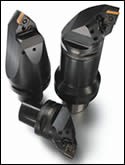Chip Control With Coolant
Directing high pressure coolant under the chip in turning applications can improve cutting rates, tool life and surface finish.
Share
The traditional role of metalworking fluids is two-fold: lubrication and chip flushing. Whether the application calls for oil or water-based coolant, its function in the operation is to form a hydraulic bushing between the cutting edge and the workpiece that helps the transfer of heat from the tool tip to the chip and then expedites the heated chip’s removal from the cutting zone.
Application of coolant is generally done using indirect flooding of the cutting zone by means of externally mounted tubing. In today’s manufacturing environment, many shops are re-evaluating the way coolant is used in metalworking—especially in turning.
Because it is a continuous cutting process, turning—and drilling—demand the cutting edge be in contact with the workpiece throughout the operation. Back in the day when cutting data were calculated around HSS, flood coolant was sufficient to keep temperatures low enough so the tool kept its edge because feeds and speeds were relatively low.
At today’s machining rates, made possible by advances in machine tools and the use of cemented carbide cutting tools, if coolant is applied conventionally into the machining zone at temperatures as high as 1,832°F (1,000°C), instant evaporation takes place. This leads to formation of a pressurized vapor zone that effectively prevents the flow of low-pressure coolant to reach the cutter edge, hence the development of high-pressure coolant systems on modern machine tools.
However, high-pressure coolant alone is only one part of the equation. To get the benefits of high-pressure coolant systems the flow must be properly aimed on the spot where it is needed. Sandvik Coromant has recently introduced a line of cutting toolholders that harnesses the machining possibilities of high-pressure coolant, which can lead to increased productivity or an increase of as much as 50 percent in tool life.
Called CoroTurn HP (high pressure), these new holders work with the Capto system of modular quick-change tooling. The new system can be applied to any machine equipped with high-pressure coolant supply and Capto couplings including multitasking machines, VTLs and turning centers.
The toolholder is equipped with two to three nozzles positioned and directed depending on the type of tool and application it is intended for. The nozzles are positioned close to the cutter/workpiece interface and, using coolant supplies of 1,000 psi, actually perform an additional function of chip control.
In operation, the HP toolholder penetrates the heat-affected zone created by the cutting action using small nozzles to cool the insert faster and more effectively and allow optimal chip control. The nozzles create a hydraulic wedge between the top surface of the insert and underside of the chip being cut from the workpiece, helping reduce insert wear and breaking the chips into smaller pieces for quicker evacuation from the cutting zone.
Although chip control in roughing operations is less critical, applying coolant precisely using the HP holder reduces cutting temperature and allows for higher cut speeds or longer tool life. Finishing operations, on the other hand, always present chip control problems because of their reduced depth of cut and feed rate. Moreover, as more shops look to perform automated production in either untended or lightly tended machining, eliminating the accumulation of “bird’s nests” is an important benefit.
Thus, applying high-pressure coolant correctly will affect productivity because of the potential for higher cutting speeds and longer tool life with fewer machine stoppages along with better predictability and security for automatic production.
Related Content
The Value of Tool Monitoring on Rotary Transfer Machines
By using a tool monitoring system, shops can save costs associated with machine maintenance and downtime for tool changes while increasing cutting performance.
Read MoreBoring Head Enables Sculpture Hardware to Be Machined on a Lathe
When small job shop Ansonia Manufacturing took on a tricky hardware component job for a “live” glass art sculpture, it realized a boring head would be needed to machine the part complete on its live-tool lathe.
Read MoreBroaching Tool Technology For Lathes Used to Slot Inconel Parts
This shop finds value in using an indexable-insert-style broaching tool to create blind-hole slots in heat-treated Inconel aerospace parts on a CNC lathe.
Read MoreReplaceable-Insert Spade Drill Basics, Advantages
Although solid carbide and indexable-insert drills have their place in a machine shop, replaceable-insert spade drills offer specific advantages for various holemaking operations on machining centers and lathes.
Read MoreRead Next
Efficient Operation With High-Pressure Coolant
Manufacturers spend millions of dollars on liquid coolants each year to help machine tools cut metal more efficiently. In many cases, however, the effect of this coolant could be greatly enhanced—in some applications by 100 percent or more—by using a high-pressure coolant delivery system.
Read More





















